Abstract
A 66-year-old man was initially suspected of having a microcystic serous cystic neoplasm based on magnetic resonance imaging findings of a multifocal mass measuring 46 mm in the pancreatic head, with a cystic component showing a high signal on T2-weighted images. The tumor marker levels were within normal limits. However, contrast-enhanced computed tomography revealed thick cyst walls with delayed staining, which was atypical for serous cystic neoplasms; therefore, the patient was followed up closely. Twenty-two months later, the delayed contrast area was enlarged, carbohydrate antigen 19–9 levels were elevated, and 18 F-fluorodeoxyglucose-positron emission tomography revealed increased accumulation, indicating a potentially malignant lesion. Pancreatoduodenectomy was performed and histopathological examination confirmed the diagnosis of normal-type pancreatic carcinoma with predominantly poorly differentiated cells. Based on the pathological findings and a literature review, it is highly likely that this case represents pancreatic ductal adenocarcinoma with a cystic structure from the beginning. While distinguishing pancreatic ductal adenocarcinoma from other pancreatic cystic tumors, such as serous cystic neoplasms, is critical owing to differing treatments and prognoses, caution is warranted as they may exhibit similar imaging features, as observed in our patient.






Similar content being viewed by others
References
Yamazaki K, Wakiya T, Ishido K, et al. A case of serous cystic neoplasm with tumor growth acceleration leading to extrapancreatic invasion. Clin J Gastroenterol. 2023;16:289–96.
Rawla P, Sunkara T, Gaduputi V. Epidemiology of pancreatic cancer: global trends, etiology and risk factors. World J Oncol. 2019;10:10–27.
Paik KY, Choi SH, Heo JS, et al. Solid tumors of the pancreas can put on a mask through cystic change. World J Surg Oncol. 2011;9:79.
Kosmahl M, Pauser U, Peters K, et al. Cystic neoplasms of the pancreas and tumor-like lesions with cystic features: a review of 418 cases and a classification proposal. Virchows Arch. 2004;445:168–78.
Garcea G, Ong SL, Rajesh A, et al. Cystic lesions of the pancreas. A diagnostic and management dilemma. Pancreatology. 2008;8:236–51.
Bagci P, Andea AA, Basturk O, et al. Large duct type invasive adenocarcinoma of the pancreas with microcystic and papillary patterns: a potential microscopic mimic of non-invasive ductal neoplasia. Mod Pathol. 2012;25:439–48.
Kosmahl M, Pauser U, Anlauf M, et al. Pancreatic ductal adenocarcinomas with cystic features: neither rare nor uniform. Mod Pathol. 2005;18:1157–64.
Sato H, Liss AS, Mizukami Y. Large-duct pattern invasive adenocarcinoma of the pancreas-a variant mimicking pancreatic cystic neoplasms: a minireview. World J Gastroenterol. 2021;27:3262–78.
Hara A, Yamada Y, Fukuzawa K, et al. “Honeycomb” appearance in large-duct type pancreatic ductal adenocarcinoma: case report with radiologic-pathologic correlation. Radiol Case Rep. 2022;17:3439–45.
Wartski M, Sauvanet A. 18F-FDG PET/CT in pancreatic adenocarcinoma: a role at initial imaging staging? Diagn Interv Imaging. 2019;100:735–41.
Ahn SJ, Park MS, Lee JD, et al. Correlation between 18F-fluorodeoxyglucose positron emission tomography and pathologic differentiation in pancreatic cancer. Ann Nucl Med. 2014;28:430–5.
Dong Q, Yang XH, Zhang Y, et al. Elevated serum CA19-9 level is a promising predictor for poor prognosis in patients with resectable pancreatic ductal adenocarcinoma: a pilot study. World J Surg Oncol. 2014;12:171.
Pergolini I, Crippa S, Salgarello M, et al. SUVmax after (18)fluoro-deoxyglucose positron emission tomography/computed tomography: a tool to define treatment strategies in pancreatic cancer. Dig Liver Dis. 2018;50:84–90.
Author information
Authors and Affiliations
Corresponding author
Ethics declarations
Conflict of interest
The authors declare that they have no conflicts of interest.
Human rights
This study was conducted in accordance with the tenets of the 1964 Declaration of Helsinki and its amendments.
Additional information
Publisher's Note
Springer Nature remains neutral with regard to jurisdictional claims in published maps and institutional affiliations.
Rights and permissions
Springer Nature or its licensor (e.g. a society or other partner) holds exclusive rights to this article under a publishing agreement with the author(s) or other rightsholder(s); author self-archiving of the accepted manuscript version of this article is solely governed by the terms of such publishing agreement and applicable law.
About this article
Cite this article
Nabeshima, Y., Takemura, N., Mihara, F. et al. A unique case of a typical pancreatic ductal adenocarcinoma that initially presented with a cystic component but underwent morphological changes. Clin J Gastroenterol (2024). https://doi.org/10.1007/s12328-024-01958-3
Received:
Accepted:
Published:
DOI: https://doi.org/10.1007/s12328-024-01958-3




